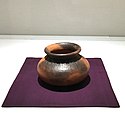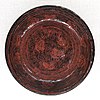Shimamono
Shimamono (島物 "island objects") is a generic term for Japanese tea utensils produced outside Japan, Korea and China, mainly from Southeast Asia.
History
Items from Korea are referred to as kōraimono (高麗物) and from China called karamono (唐物) are not considered shimamono.
They were imported with ships on trade routes and started becoming popular in the 15th and 16th centuries. The term therefore can be taken literally to mean "island objects". By the time of the rule of the Shōgun Tokugawa Yoshimune, imitation shimamono were also produced in Japan. However, at this point they were called "striped objects", but the pronunciation remained the same.[1] As such they can be counted as part of Japanese pottery and porcelain.
The treatise Tōkikō describes the Japanese pottery trade with Asia and gives detailed descriptions.[2]
Types
| Name | Kanji | Origins | Notes | Example image |
|---|---|---|---|---|
| Rusun ware | 呂宋焼 | Luzon | Pottery items. The merchant Ruson Sukezaemon (呂宋助左衛門) was particularly connected to the trade in Rusun ware during the rule of Toyotomi Hideyoshi in the 16th century.[3][4][5] Grouped together with Mishima ware | [6]
|
| Annan ware | 安南焼 | Annam | Often blue and white pottery that was later developed in Japan also in red and green colours. |  |
| Nanban ware | 南蛮焼 | Southeast Asia | Items from southeast Asia without exact provenience |  [7][8][9] [7][8][9] |
| Amakawa | アマカワ | unidentified location | white clay and grayish glaze. Grouped together with Mishima ware | |
| Mōru / Mo-ru | モウル / モール | Moluccas | [10] | |
| Tō Indu / Tenji | 東インドゥ | eastern India | ||
| Kōchi ware | 交趾焼 | southern China | developed from Cochin ware from southern China. Generally in colours yellow, green and blue. |  |
| Nekoro | ネコロ | Nicobar Islands | ||
| Taiwan | 臺灣 | Taiwan | Grouped together with Mishima ware | |
| Hannera | ハンネラ | Southeast Asia | a type of simple unglazed ware, often reddish or orange in colour |  [11] [11] |
| Kinma | 蒟醤 | Siam or Burma | a style of lacquer ware with finely inlaid patterns |  [12] [12] |
| Koma | 独楽 | Siam | lacquerware, called "spinning top" (koma) because the colours are painted in concentrical rotating patterns | [13] |
| Sahari | 砂張 | Southeast Asia | Alloy mainly made of copper, but it may particularly refer to products of Southeast Asian origin | [14][15] |
See also
References
- ^ https://archive.org/stream/chinesepotteryi01laufgoog#page/n40/mode/2up
- ^ https://archive.org/stream/chinesepotteryi01laufgoog#page/n40/mode/2upe
- ^ Manansala, Paul Kekai (October 2006). Quests of the Dragon and Bird Clan. ISBN 9781430308997.
- ^ sambali.blogspot.com/2006/09/luzon-jars-glossary.html
- ^ http://photos1.blogger.com/blogger/6514/3214/1600/Kyoto%20002.jpg
- ^ http://hikone-castle-museum.jp/collection/286.html
- ^ http://utsuwanote.exblog.jp/17807725/
- ^ http://utsuwanote.exblog.jp/12045289/
- ^ http://utsuwa-shoken.shop-pro.jp/?pid=115520126
- ^ https://seiyudo.ocnk.net/product/4708
- ^ http://www.miho.or.jp/booth/html/artcon/00000262.htm
- ^ http://www.tnm.jp/modules/r_free_page/index.php?id=354
- ^ https://mingeiarts.com/product/vintage-japanese-tea-ceremony-chu-natsume-kagawa-lacquer-tea-caddy-1940s/
- ^ http://webarchives.tnm.jp/imgsearch/show/C0077196
- ^ http://www.gotoh-museum.or.jp/collection/col_05/02098_001.html
Literature
![]() Media related to Shimamono at Wikimedia Commons
Media related to Shimamono at Wikimedia Commons


